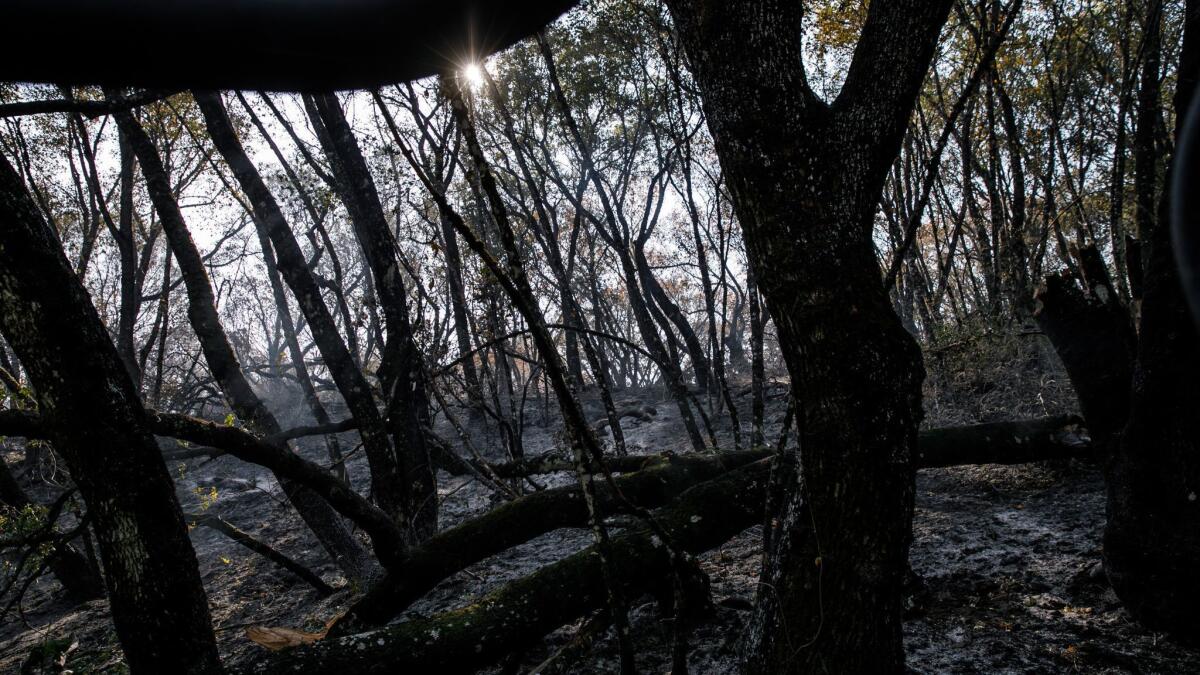Pacific Gas & Electric equipment blamed for another of last year’s deadly fires in California

- Share via
An electrical arc between two Pacific Gas & Electric conductors caused the Cascade fire in Yuba County last year that killed four people and destroyed hundreds of homes during California’s deadliest wildfire outbreak in modern history, state officials announced Tuesday.
The fire was among hundreds that erupted last year in Northern California on Oct. 8 and 9, when high winds knocked down trees and branches and put PG&E equipment in contact with tinder-dry brush.
Minus a few blazes that are still under investigation, including the Tubbs fire that killed 22 people, PG&E equipment has been found to have caused or contributed to more than a dozen of the biggest fires from last year’s siege.
The Cascade fire ignited about 11 p.m. Oct. 8, north of Collins Lake. It destroyed 264 structures and burned 9,989 acres before it was fully contained in February.
“A high wind event in conjunction with the power line sag on two conductors caused the lines to come into contact, which created an electrical arc,” the California Department of Forestry and Fire Protection, or Cal Fire, said in a statement. “The electrical arc deposited hot burning or molten material onto the ground in a receptive fuel bed causing the fire. The common term for this situation is called ‘line slap’ and the power line in question was owned by the Pacific Gas and Electric Company.”
California’s landscape last fall and winter was primed for fire. An epic winter the previous year produced a blanket of grass and light brush that cured in record-breaking summer heat, setting the stage for fast-moving blazes.
The weekend of the October fires, wind gusts topped 70 mph in some places and pushed flames through rural canyon passes and toward homes, which ignited and then shot embers across roads and freeways into suburban settings, ultimately destroying entire neighborhoods in Fountain Grove and Santa Rosa in Sonoma County.
“Without question, the loss of life, homes and businesses in these extraordinary wildfires is heartbreaking and we remain focused on helping communities recover and rebuild,” the utility said in a statement. “We look forward to the opportunity to carefully review the Cal Fire report to understand the agency’s perspectives. In the meantime, we are continuing to focus on implementing additional precautionary measures intended to further reduce wildfire threats, such as working to remove and reduce dangerous vegetation, improving weather forecasting, upgrading emergency response warnings, making lines and poles stronger in high fire threat areas and taking other actions to make our system, and our customers and communities, even safer in the face of a growing wildfire threat.”
Though PG&E equipment caused the Cascade fire, investigators found the utility did not violate state codes in how it was maintained.
“Unfortunately, there’s just some things that Mother Nature is going to do that you can’t prevent,” said Mike Mohler, a Cal Fire spokesman.
Regardless, the utility giant is facing hundreds of legal claims — many on behalf of home insurers looking to recoup their losses — and already has written down $2.5 billion in pre-tax charges for wildfire liabilities. It stopped dividend payments to shareholders late last year and warned consumers and lawmakers that it could face bankruptcy if it was required to pay under the state’s unusual inverse condemnation laws that hold utilities financially liable if their equipment played a role in a fire, even if it was maintained properly under state laws.
To that end, Gov. Jerry Brown signed SB 901 last month. Dubbed a “PG&E bailout” by critics, the law allows PG&E to borrow money for its 2017 wildfire costs and use dollars collected from customers to repay the loan. A financial “stress test” would determine how much PG&E could pay while remaining solvent and how much would be passed on to ratepayers.
The results of Cal Fire’s investigation were forwarded to the Yuba County district attorney’s office, as is standard protocol, officials said. Yuba County prosecutors said Tuesday they would not press charges against the company.
For breaking California news, follow @JosephSerna on Twitter.
UPDATES:
3:50 p.m.: This article was updated with Yuba County prosecutors declining to charge PG&E.
This article was originally published at 1 p.m.
More to Read
Sign up for Essential California
The most important California stories and recommendations in your inbox every morning.
You may occasionally receive promotional content from the Los Angeles Times.










